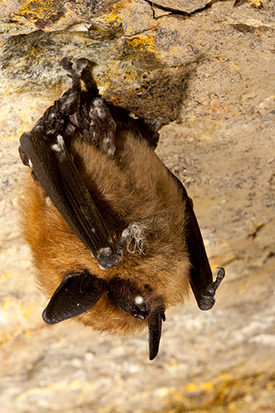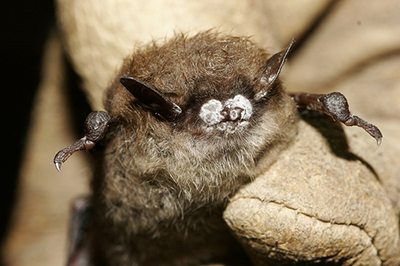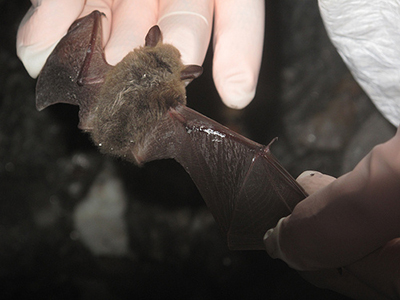
White nose syndrome threatens ecosystems
White-nose syndrome (WNS) is a relatively new disease found to wreak havoc on the bat population in North America.
Many national parks, including Mammoth Cave National Park, Cumberland Gap National Historical Park, Great Smoky Mountains National Park, Acadia National Park, have been affected by this devastating disease.
White-nose syndrome threatens not only the bat population within these caves, but also the stability and natural existence of the cave ecosystems of North America.
| At right, an Eastern small-footed bat with white-nose syndrome. Below, a little brown bat with a nose with fungus in New York in 2008 (Photos courtesy of Ryan von Linden, New York Dept. of Environmental Conservation). |  |
WNS targets the metabolic processes within bats, and affects hibernation patterns.
According to Mammoth Cave National Park Public Information Officer Vickie Carson, the problem is not widely known.
“Still not a whole lot is known about white nose, but it does cause bats to wake up out of their deep hibernation. When they wake up they use up energy and water that they’ve stored… before hibernation is over with. So bats, when found dead, have low body fat and their weight is way less than it should be,” she said.
Geomyces destructans is the scientific name for the fungus that is thought to be responsible for white-nose syndrome. This is a cold-weather fungus, which can reproduce at temperatures below 68 degrees Fahrenheit and is thought to grow on bats as they hibernate in caves.
Once bats become infected with the disease, they develop white fuzz on their noses, and other body parts including wings. They also display unusual behavior, typically waking up from hibernation too early, flying in the daytime and even attempting to hunt insects that aren’t there.
 This disease is so potent that the National Speleological Society (NSS), a cave advocacy group, has created a Rapid Response Fund for donations towards WNS research.
This disease is so potent that the National Speleological Society (NSS), a cave advocacy group, has created a Rapid Response Fund for donations towards WNS research.
According to NSS spokesperson Michelle Vaughn, “White-nose is waking (bats) up out of their hibernation too soon. Because there is a lack of food when they wake up early, they are starving to death.… A 90 percent mortality rate is pretty devastating.”
White-nose syndrome has spread to 19 U.S. states and four Canadian Provinces since it first appeared in a bat cave in New York in 2006.
This disease was unknown to researchers until its debut and has since proven its destructive capabilities.
Estimates from the U.S. Fish and Wildlife Service find that 6.7 million bats have died since the disease first appeared. These alarming research findings give plenty to worry about for environmental groups like the NSS and the National Park Service.
Scientists are concerned for the ecosystems surrounding infected caves.
“It’s not so much the ecosystem in the caves we’re concerned about. White-nose syndrome is affecting everything else, because the bats eat so many bugs. They’ll eat half their own body weight in bugs every night. It’s affecting agriculture, it’s affecting our general comfort outdoors at night,“ Vaughn stated.
Without the bat population to keep insect population at bay, we could see a devastating shift in the balance of nature in North America.
Although the spread of the disease is not known for sure, it is suspected that humans’ traveling between caves carrying the fungus on hiking boots or sneakers could be linked to fungal spread between cave sites.
Other schools of thought argue that humans are not responsible, and that bat-to-bat contact is the primary mode of fungal spread.
To be safe, park officials are taking every precaution necessary.
According to Miranda Shalleen, park spokesperson and tour guide at Wind Cave National Park, a park that has yet to see an occurrence of WNS, efforts to educate the public are needed.
“What we are trying to do is prevent the fungus from growing inside our cave walls. This is where education of the visitors who come to Wind Cave plays a very big role because we do ask that you keep any kind of contaminated clothing from other caves that you might have been in from entering our cave passages,” he explained.
At Mammoth National Park, a park contaminated with this disease as of January, officials were taking precautions similar to the ones Shalleen described.
 |
A bat with a visible fungus on its wing in a North Carolina mine (Photo courtesy of Sue Cameron, U.S. Fish and Wildlife Service). |
“We would screen visitors before they got here, to find out if they had been in a cave or a mine, and if they had we’d ask that they change their clothes. If they were wearing the same shoes or boots we would treat their shoes or boots by walking over a special turf,” Mammoth Cave National Park Public Information Officer Vickie Carson explained.
Despite the precautions taken, white-nose syndrome managed to seep its way into the cave. Newer methods are also being devised.
“We also are getting ready to use a different method, which would use a solution of Woolite (designed to cure the fungus), which we would put into a biosecurity vat,” she said.
While many aspects of White-nose syndrome remain a mystery, one thing is for certain: The spread of this fungus could cause grave consequences for ecosystems across North America. If the number of insect-hunting bats decreases drastically, insect population will inflate. This has the potential to create a serious imbalance in North American ecosystem food chains. Scientists are still working diligently to come up with feasible solutions to this biological conundrum.

Comments are Closed